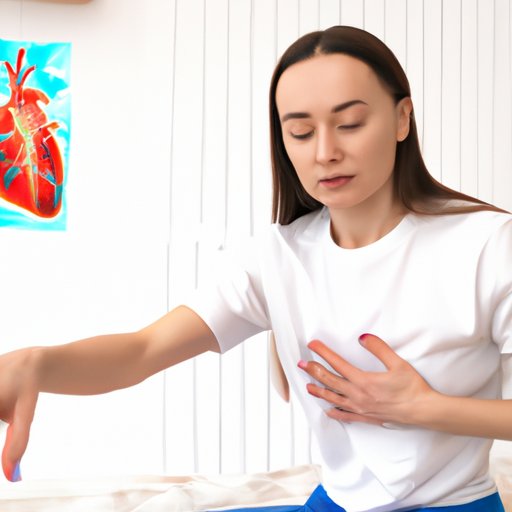
Introduction
Postural Orthostatic Tachycardia Syndrome (POTS) is a type of dysautonomia, a disorder that affects the autonomic nervous system. It is a condition that can cause a wide range of symptoms, making it challenging to diagnose. POTS is a relatively uncommon condition, affecting about 1-3 million Americans. Recognizing the signs of POTS and the range of symptoms that come with it is crucial to seek medical help if necessary.
The 5 Most Common Symptoms of POTS You Need to Know
The most common symptoms of POTS include:
- Dizziness
- Fatigue
- Heart racing
- Shortness of breath
- Headaches
These symptoms are not exclusive to POTS and can be caused by various other conditions. However, if you experience one or more of these symptoms, it is worth consulting with your doctor to determine the cause.
From Dizziness to Fatigue: Recognizing the Signs of POTS
Dizziness and lightheadedness are common symptoms of POTS and are often caused by a drop in blood pressure upon standing. You may feel faint, dizzy, or lightheaded when changing positions from lying down to sitting up or standing. Fatigue is a frequently reported symptom that can be linked to the body’s increased effort to maintain blood pressure and heart rate when moving.
Tips for recognizing these symptoms include keeping a journal of your symptoms and their times of occurrence, standing up slowly instead of rapidly from a lying or sitting position to help reduce dizziness, and sitting down if you begin to feel lightheaded or dizzy.
POTS Symptoms: Is Your Heart Racing for No Reason?
POTS can cause heart racing, which is often described as a fluttering or pounding sensation in the chest. This symptom can happen even if you’re sitting or lying down and is one of the most unsettling sensations associated with POTS. Heart racing can also increase heart rate upon standing up, causing a fast pulse and sometimes difficulty breathing.
Recognizing this symptom in yourself might include taking note of when the heart racing occurs, avoiding stressors, caffeine, and alcohol, any other physical activity that may cause an increase in heart rate. A wearable fitness tracker or pulse oximeter may help track your pulse rate in real-time and provide you with more data on heart racing upon standing.

When Gravity Takes its Toll: Understanding POTS Symptoms
Gravity can worsen POTS symptoms because of the disorder’s effect on blood volume and the heart’s ability to pump blood effectively. This can occur when standing up for long periods, going up stairs, and even during casual walking. Symptoms that can worsen with gravity include heart racing, dizziness, headaches, shortness of breath, and many other physical symptoms.
A reclined position can temporarily relieve these symptoms when they become severe. Engaging in low-impact exercises, staying hydrated, and eating small, frequent meals can help reduce the severity of these symptoms.
The Invisible Illness: Spotting POTS Symptoms in Your Body
POTS is an invisible illness, which means that the majority of its symptoms can’t be detected easily or observed by others. This makes it challenging to diagnose, and many patients receiving belittlement in hospitals. Frequently reported, unobservable symptoms of POTS include cognitive functioning, temperature regulation problems, and digestion issues.
Noticing these symptoms in yourself can include monitoring your wellbeing through journaling or reflecting on your daily routine. If you’re experiencing significant issues with daily tasks or cognitive functioning, it’s essential to speak with a doctor and seek medical help.
POTS 101: Noticing the Signs and Symptoms for Early Diagnosis
Early diagnosis of POTS is necessary to prevent it from becoming more severe than it’s sometimes diagnosed too late. The signs and symptoms of POTS should be recognized early on to ensure timely intervention.
Tools for identifying POTS symptoms include monitoring changes in daily patterns of physical fatigue, extreme temperature regulation problems, and noticing cognitive functioning disruptions. Documenting symptoms and speaking with healthcare providers can lead to treatment and the early management of POTS symptoms.
How to Identify POTS in Your Daily Life: 7 Key Symptoms to Look For
7 common symptoms of POTS to look out for include:
- Lightheadedness, particularly when standing for long periods
- Fatigue and malaise after physical activity
- Heart palpitations or rapid heartbeat while in a stationary position
- Dizziness
- Brain fog impairing cognitive functioning
- Migraines
- Heat intolerance or difficulty regulating temperature
Recognizing these symptoms in your daily life can help identify POTS early and help maintain effective treatment and management of POTS symptoms.
Conclusion
POTS is a disorder that affects the autonomic nervous system and causes a wide range of symptoms. This article aimed to identify the five most common symptoms of POTS, providing tips for recognizing these signs. The emphasis must be on the significance of early diagnosis and intervention in managing POTS symptoms. If you’re experiencing symptoms that are concerning to you, it’s crucial to speak with a doctor and seek medical help.




